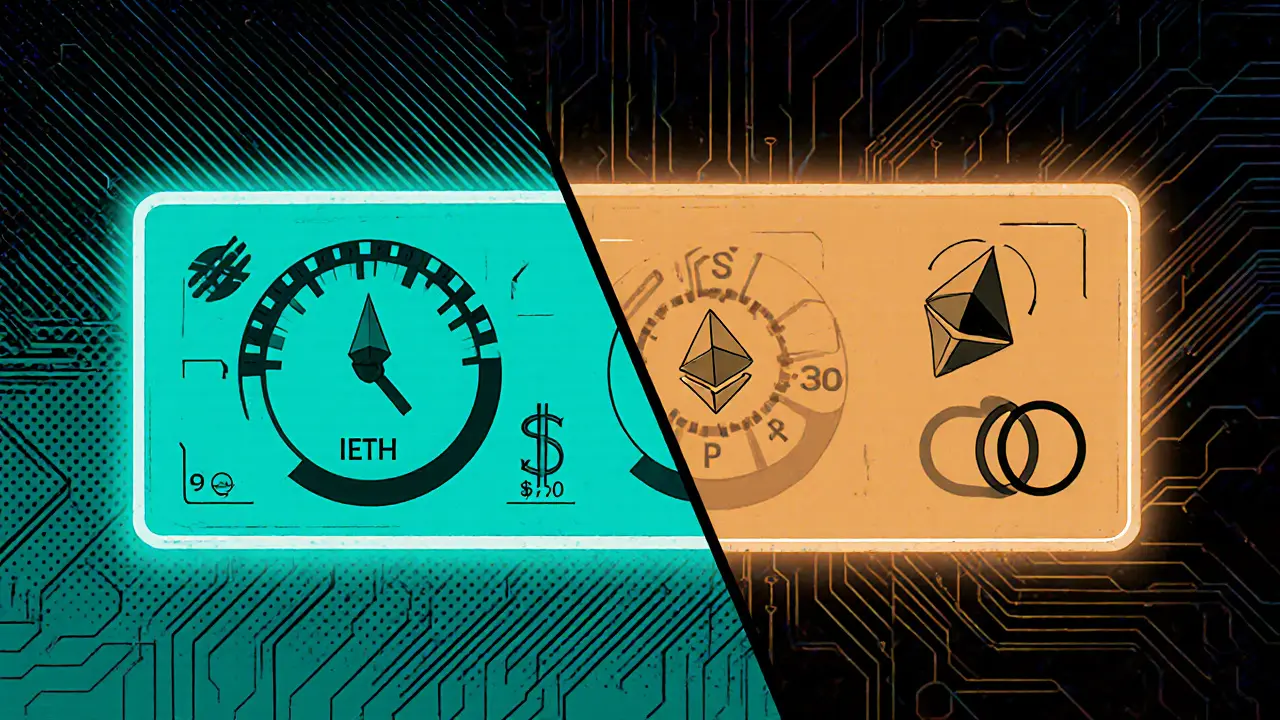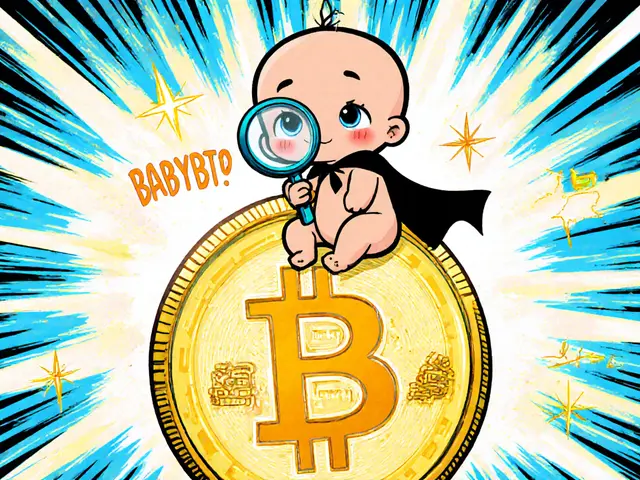- Home
- Cryptocurrency
- iEthereum (IETH) Explained: What It Is, How It Works & Why It Matters

iEthereum (IETH) Explained: What It Is, How It Works & Why It Matters
iEthereum vs Ethereum Comparison Tool
iEthereum (IETH)
A fork of Ethereum with improved speed, lower fees, and on-chain governance.
- Launch Year: 2022
- Consensus: Proof-of-Stake (PoS) with fast finality
- Max Supply: 210 million
- Avg Fee: ~$0.02
Ethereum (ETH)
The original blockchain platform with smart contracts and massive adoption.
- Launch Year: 2015
- Consensus: Proof-of-Stake (PoS) since The Merge
- Max Supply: None (inflationary)
- Avg Fee: ~$0.30
Detailed Feature Comparison
| Feature | iEthereum (IETH) | Ethereum (ETH) |
|---|---|---|
| Consensus Mechanism | Proof-of-Stake (PoS) with fast finality | Proof-of-Stake (PoS) after The Merge |
| Transaction Speed | Under 5 seconds finality | ~12 seconds |
| Average Transaction Fee | ~$0.02 | ~$0.30 (variable) |
| Token Supply | Fixed at 210 million | Inflationary (no cap) |
| Governance Model | On-chain voting with IETH weight | Off-chain EIP process |
| EVM Compatibility | Fully compatible | Fully compatible |
| Network Maturity | Relatively new (2022 launch) | Established (since 2015) |
Key Differences Summary
- Speed: iEthereum offers faster transaction finality (~5 seconds vs ~12 seconds) Faster
- Cost: iEthereum maintains very low transaction fees (~$0.02 vs ~$0.30) Cheaper
- Supply: iEthereum has a fixed maximum supply (210M) vs Ethereum's inflationary model Limited
- Governance: iEthereum enables on-chain voting by token holders Democratic
- Adoption: Ethereum has much wider ecosystem and liquidity Established
Important Note
This comparison tool helps illustrate the key distinctions between iEthereum and Ethereum. While iEthereum offers several advantages such as lower fees and faster finality, it remains a relatively new project with less established infrastructure compared to Ethereum. Always research thoroughly before making any investment decisions.
Quick Take
- iEthereum (IETH) is a fork‑style crypto coin that builds on Ethereum’s tech stack.
- It uses a proof‑of‑stake (PoS) consensus, aims for lower fees, and adds a governance layer.
- You can store IETH in any ERC‑20 compatible wallet and trade it on a handful of niche exchanges.
- Token supply is capped at 210million, with 40% allocated to community incentives.
- Like any new coin, price can swing wildly - do your homework before buying.
When people hear iEthereum a crypto coin that tries to improve on the original Ethereum network, the first question is usually “Is it just another copy?” The short answer is no. iEthereum (ticker IETH) takes Ethereum’s core ideas - smart contracts, a robust developer ecosystem, and a PoS consensus - and repackages them with a few tweaks aimed at speed, cost‑efficiency, and community‑driven upgrades. Below we break down what makes iEthereum different, how you can get your hands on it, and what to watch out for.
What Is iEthereum?
iEthereum (IETH) is a cryptocurrency designed to function as a parallel layer to the Ethereum blockchain. Launched in 2022 by a team of former Ethereum developers, the project’s whitepaper (available on its GitHub repo) promises three main goals:
- Reduce transaction fees by introducing a dynamic gas‑pricing model.
- Increase block finality speed from ~12 seconds to under 5 seconds.
- Empower token holders with a formal on‑chain voting mechanism for protocol upgrades.
From a technical standpoint, iEthereum runs a proof‑of‑stake consensus algorithm where validators lock up IETH to secure the network. The network’s native token, IETH, doubles as both a medium of exchange and a stake‑holding asset.
Core Features and How They Work
Here are the building blocks you’ll see repeated across iEthereum’s documentation:
- Smart‑contract compatibility: iEthereum supports the Ethereum Virtual Machine (EVM), meaning any Solidity contract that runs on Ethereum can be deployed on iEthereum with minimal changes.
- Dynamic gas pricing: Instead of a fixed gas price, the protocol adjusts fees based on network congestion, keeping average costs under $0.02 for most transactions.
- Fast finality: A two‑round validator checkpoint reduces the time needed for a transaction to become irreversible.
- On‑chain governance: Holders can propose and vote on upgrades using IETH‑weighted ballots, similar to the DAO model on Ethereum.
- Fixed supply: The total max supply is 210million IETH, with 40% earmarked for community grants, 30% for developers, 20% for staking rewards, and 10% for early investors.
iEthereum vs. Ethereum: A Quick Comparison
| Aspect | iEthereum (IETH) | Ethereum (ETH) |
|---|---|---|
| Launch year | 2022 | 2015 |
| Consensus | Proof‑of‑Stake (PoS) with fast finality | Proof‑of‑Stake (PoS) after The Merge |
| Native token symbol | IETH | ETH |
| Max supply | 210million | None (inflationary) |
| Average transaction fee | ~$0.02 | ~$0.30 (varies widely) |
| Governance model | On‑chain voting with IETH weight | Off‑chain EIP process (Ethereum Improvement Proposals) |
Think of iEthereum as a “leaner” sibling. It keeps the DNA that developers love - EVM compatibility, DeFi primitives, NFT standards - while trimming the fat that can make Ethereum feel pricey or slow for everyday users.

How to Get iEthereum
If you’re ready to explore IETH, follow these steps:
- Set up a wallet that supports ERC‑20 and custom EVM chains. Popular choices are MetaMask (add a custom network), Trust Wallet, and the iEthereum‑official desktop wallet.
- Add the iEthereum network to your wallet:
- Network name: iEthereum Mainnet
- RPC URL: https://rpc.ieth.io
- Chain ID: 2025
- Currency symbol: IETH
- Block explorer URL: https://explorer.ieth.io
- Buy IETH on a supported exchange that lists the token. As of Oct2025 the most reliable platforms are:
- Binance (IETH/USDT pair)
- KuCoin (IETH/BTC pair)
- Decentralized exchange Uniswap v4 on the iEthereum network
- Transfer the purchased IETH to your personal wallet. Double‑check the address format - iEthereum uses the same 0x‑prefixed address style as Ethereum.
- If you plan to stake, lock at least 10000 IETH in the official staking contract. Stakers earn a baseline 5% annual yield plus additional rewards for validator performance.
Remember, every exchange has its own KYC requirements, fee schedule, and withdrawal limits. Compare them before committing large sums.
Risks and Things to Keep an Eye On
Like any emerging crypto, IETH carries a mix of technical and market risks:
- Project maturity: iEthereum is only a few years old. The codebase is still being audited, and a major bug could affect funds.
- Liquidity: Trading volume is modest compared to ETH. Large sell orders can move the price sharply.
- Regulatory exposure: Some jurisdictions treat newer tokens as securities. Check local rules before buying.
- Validator concentration: If a few large validators control most of the stake, the network could become centralized.
- Competing forks: Projects like “EcoEthereum” and “LayerZero” are also targeting lower fees, which could split the community.
Mitigation tip: never invest more than you can afford to lose, and consider diversifying across several established assets.
Community, Roadmap, and Governance
The iEthereum team runs an open‑source repo on GitHub where anyone can submit pull requests. Quarterly, the community votes on proposals ranging from fee‑structure tweaks to new virtual machine upgrades. The most recent roadmap (Q42024‑2025) includes:
- Integration with Layer‑2 rollups for sub‑second finality.
- Launch of an iEthereum‑native decentralized identity (DID) system.
- Partnership with a major gaming studio to power in‑game economies.
- Implementation of a “green staking” incentive that rewards validators using renewable‑energy sources.
Active channels are the official Discord (with over 12k members), Telegram, and a monthly AMA on YouTube. Engaging with the community is the best way to stay ahead of protocol changes.
Quick Checklist for New IETH Holders
- Install an ERC‑20 compatible wallet and add the iEthereum network.
- Buy IETH on a reputable exchange (Binance, KuCoin, or Uniswap‑iETH).
- Secure your private keys - never share them.
- Consider staking at least 10000 IETH for passive rewards.
- Follow the official Discord for updates and governance votes.
- Regularly review the token’s price‑impact on your portfolio.
Frequently Asked Questions
What makes iEthereum different from regular Ethereum?
iEthereum keeps full EVM compatibility but adds a faster PoS finality model, a capped token supply, and built‑in on‑chain governance. The result is lower fees and quicker transaction confirmation compared with Ethereum’s current network.
Can I use the same wallet for ETH and IETH?
Yes. Most Ethereum wallets (MetaMask, Trust Wallet, Ledger hardware) let you add a custom network for iEthereum, letting you hold both ETH and IETH side‑by‑side.
Is iEthereum a good investment?
Investing in any young crypto carries risk. IETH offers attractive tech features, but its market depth is limited. Treat it as a speculative asset and only allocate a small portion of your portfolio.
How do I stake IETH?
Visit the official staking portal at https://stake.ieth.io, connect your wallet, and lock a minimum of 10000 IETH. Rewards are distributed weekly and can be withdrawn after a 30‑day unbonding period.
Where can I track iEthereum transactions?
The dedicated block explorer https://explorer.ieth.io shows real‑time transaction details, validator status, and gas statistics for the iEthereum network.
Cormac Riverton
I'm a blockchain analyst and private investor specializing in cryptocurrencies and equity markets. I research tokenomics, on-chain data, and market microstructure, and advise startups on exchange listings. I also write practical explainers and strategy notes for retail traders and fund teams. My work blends quantitative analysis with clear storytelling to make complex systems understandable.
Popular Articles
9 Comments
Write a comment Cancel reply
About
DEX Maniac is your hub for blockchain knowledge, cryptocurrencies, and global markets. Explore guides on crypto coins, DeFi, and decentralized exchanges with clear, actionable insights. Compare crypto exchanges, track airdrop opportunities, and follow timely market analysis across crypto and stocks. Stay informed with curated news, tools, and insights for smarter decisions.







iEthereum actually looks kinda solid for a new chain. Low fees and fast finality? Sign me up. Been waiting for something that doesn't make me cry when I send a simple NFT.
Just hope they don't get greedy with staking rewards later.
I've been holding IETH since launch. Not rich yet but the community is real. Discord is way more active than Ethereum's.
Let me be the first to say this: anyone who thinks this is "just another fork" hasn't studied the EVM properly. The governance model is amateur hour. On-chain voting with a 210M cap? That's not decentralization, that's a marketing brochure written by a 19-year-old with a Figma account.
And don't get me started on "green staking." If you're using renewable energy to validate blocks, you're probably running a Raspberry Pi in your mom's basement. This isn't innovation-it's virtue signaling with a blockchain.
I get where Claymore is coming from, but I think there's real potential here. The fact that they're targeting sub-second finality and keeping fees under 2 cents? That's huge for everyday users. I've used Ethereum for years and honestly, it's become a luxury product. iEthereum feels like it's built for people, not just degens.
And the DID integration? That could be game-changing for Web3 identity. I'm not saying it's perfect, but I'm willing to give it a shot. Diversify, don't dismiss.
I have reviewed the technical documentation and find the dynamic gas pricing model to be statistically significant in reducing transactional friction. However, I must emphasize that the absence of a formal third-party audit report raises material concerns regarding contract integrity. I recommend awaiting independent verification prior to capital allocation.
Another foreign crypto trying to steal America's tech crown. Ethereum was built by real engineers, not some Indian dev team with a Discord server. Why not just use Bitcoin? At least that's got history. This IETH nonsense is just another crypto scam dressed up like progress.
iEthereum... or is it iEthereum? I keep forgetting the capitalization. Anyway, I think the real question is: if you're building a fork to fix Ethereum, why not just help fix Ethereum? Isn't that more... noble? Like, if your house is leaking, do you build a new house or fix the roof?
Also, 210 million? That number feels... arbitrary. Like someone picked it because it's 10 million more than Bitcoin. Just saying.
Okay but what if the staking contract gets hacked?
What if the devs just vanish after the airdrop?
What if the "community voting" is just the core team voting with 50 wallets?
What if this is all just a pump for the early investors?
What if I'm just being paranoid?
...I'm still in.
I've been researching this for weeks. And I'm not just talking about the whitepaper. I've dug into the GitHub commits, cross-referenced the team's LinkedIn profiles with old crypto forums, and even analyzed the metadata of their Discord avatar. There's a pattern. This isn't a blockchain project. It's a psychological operation. The "community grants"? That's a front for laundering funds through shell DAOs. The "green staking"? A cover for energy-intensive mining disguised as sustainability. They're not trying to improve Ethereum-they're trying to replace the entire financial system with a controlled narrative. And if you're buying IETH, you're not investing. You're being recruited.